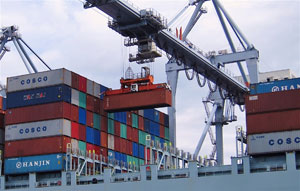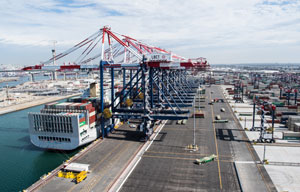Amid the COVID-19 crisis, all of the terminals in San Pedro, Calif., remain open, but ship traffic has decreased and the amount of cargo transiting both ports — Los Angeles and Long Beach — declined significantly through the first four months of the year. The anchorages in the San Pedro roadstead were full of cruise ships going nowhere, loaded car carriers with no place to offload, and tankers with full loads but no buyers.
That has required an even higher degree of vigilance on the part of the Marine Exchange of Southern California, which collects and shares information and manages vessel traffic services (VTS) for all stakeholders in both ports. In addition, the entire San Pedro Bay Port Complex is on heightened alert, and the U.S. Coast Guard is assessing all inbound vessels.
The busy complex is home to two neighboring yet competing seaports. Each has its own terminals, pilots, security and tugboats. But one thing they both rely upon is the marine exchange. Its services ensure safe navigation and the movement of commerce, reducing risk to vessel owners, vessel operators and supply chains.
The VTS sensor network of radars, cameras and the automatic identification system (AIS) allows the exchange to monitor all vessel movements to ensure safe navigation in and out of the ports. Wave buoys are installed outside the ports to provide wave height and direction, with real-time data allowing sophisticated computer models to generate wave forecasts.
Of the 12 VTS systems in major port areas around the United States, all are government-run with the exception of the Southern California operation, which is a unique public-private partnership. The nonprofit exchange is supported by user fees that cover the salaries of 20 employees. Six Coast Guard members — their salaries are the only taxpayer expense — have law enforcement authority.
Retired Coast Guard Capt. Kip Louttit is the exchange’s director. He reports to a board that has representation from the various government and industry stakeholders in the area, including containership, break-bulk, tanker, tug and barge, terminal and local passenger vessel operators, as well as pilots, steamship agents, the ports of Los Angeles and Long Beach, and the maritime law community.
Safety as a service
With an average of about 4,500 ship arrivals at the port complex in any given year, and 50 to 60 ships in port on any given day, the exchange’s maritime information service (MIS) — a 24/7 data feed to subscribers — collects, collates and promulgates the schedule for all ships arriving, departing and moving inside the ports.
Louttit said the exchange has helped to significantly reduce risk for all stakeholders. “In the 25 years since our VTS has been in business, there hasn’t been a collision, allision or grounding of more than 600,000 participating vessels,” he said.
Arrivals by containerships, vehicle ships, bulk carriers and general cargo ships remain below historic averages during the pandemic. Due to the number of tankers and cruise ships at anchor, the exchange is using both regular and contingency anchorages. “The pilots, Coast Guard and VTS monitor the situation carefully and there have been no VTS issues,” Louttit said.
The number of ships coming into the port complex for “bunkers only,” which means they are only taking on fuel, is at “triple normal levels,” he said.
 |
|
A container is loaded onto Cosco Guangzhou at the Port of Long Beach. About 4,500 ships arrive at the San Pedro Bay Port Complex every year, with the Marine Exchange of Southern California coordinating the interaction between terminals, pilots, security and tugboats. |
|
Courtesy Marc/Flickr |
Information as a commodity
“(The marine exchange) is the trusted maritime information clearinghouse, disseminating accurate, timely and pertinent info to keep America’s massive logistic chain moving smoothly, quickly, safely and efficiently,” said Capt. Manny Aschemeyer, a master mariner and former executive director of the exchange. “That includes all kinds of consumer goods found on the shelves at Target, Walmart, Home Depot, and thousands of other retail and commercial outlets all across the country — from food supply items, import and export vehicles, bulk and raw materials, building materials such as lumber and steel, and petroleum products from crude oil to refined products, as well as LPG and LNG. It benefits our country and all of its citizens in every way imaginable.
“The exchange does more than just answer the age-old query, ‘Has my ship come in?’ It assures safe navigation, vessel security, port efficiency and environmental protection,” he said.
The Coast Guard captain of the port (COTP) relies on the exchange to help maintain maritime domain awareness across Southern California to ensure the safe, secure, efficient, reliable and environmentally sound movement of vessels.
MIS provides a valuable commodity that is used to plan tug movements, assign pilots, direct line handlers, manage stevedores and crane operators, schedule Coast Guard inspections, and notify customs and immigration officers. Without it, shipments would be delayed, resulting in costly disruptions to logistics enterprises.
Arrival and departure schedules must be carefully planned and executed. With ships departing, arriving or shifting berths, there is always something moving. Vessels constrained in their ability to maneuver must be handled with care.
“We have ships coming with just a meter of water under the keel,” Louttit said. “Some are so tall that we can’t turn them around in the turning basin, and we have to turn them around in the outer harbor and back them down to their berth. This creates additional challenges for the pilots, tugboats, law enforcement escorts and everyone involved in a complicated move.”
There are a lot of port workers — line handlers, longshoremen, crane operators and truck drivers — involved with managing a ship from when it reaches the berth to when it departs. Delays cost money and can have a ripple effect.
Continuity amid COVID
The COVID-19 crisis has had a major impact on the San Pedro ports. According to the Port of Long Beach, dockworkers and terminal operators moved 519,730 twenty-foot equivalent units (TEUs) in April, down 17.3 percent from the same month a year ago, which remains the port’s busiest April on record. Imports slid 20.2 percent to 253,540 TEUs, while exports declined 17.2 percent to 102,502 TEUs. Empty containers headed overseas decreased 12.2 percent to 163,688 TEUs. The port moved 2.2 million TEUs during the first four months of 2020, down 9.5 percent down from the same period in 2019.
“The coronavirus is delivering a shock to the supply chain that continues to ripple across the national economy,” said Mario Cordero, executive director of the Port of Long Beach. “We’re definitely seeing a reduction in the flow of cargo at San Pedro Bay, but the ports remain open and operating, and we are maintaining business continuity.”
Gene Seroka, executive director of the Port of Los Angeles, said the trade war between the U.S. and China and now the pandemic have impacted the supply chain. “With U.S. retailers and cargo owners scaling back orders, volumes are soft even though factories in China are beginning to produce more. Amid this public health crisis, there will be uncertain months ahead in the global supply chain,” he said.
Retired Navy Capt. Edward Lundquist is a communications professional with 37 years of public affairs, public relations and corporate communications experience in military, private association and corporate service. During his 24-year naval career, Lundquist qualified as a surface warfare officer and later served as a public affairs officer. He retired from active duty in 2000.

